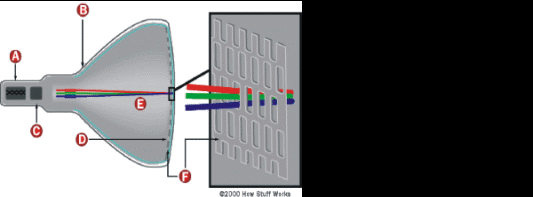SUBSKILL 3 RECALL INFORMATIONPASSAGE DETAILS II READ THE
SUBSKILL 10 CONSTRUCT MEANING COMPARE AND CONTRAST PARTSUBSKILL 101 PUNCTUATIONEND MARKS I IN THE FOLLOWING
SUBSKILL 103 PUNCTUATION COMMAS COMPOUND SENTENCE SERIES I
SUBSKILL 12 PUNCTUATION SEMICOLONS & COLONS PART II
SUBSKILL 17 PARAGRAPH DEVELOPMENT SUPPORTING SENTENCES I FOR
SUBSKILL 17 PARAGRAPH DEVELOPMENT SUPPORTING SENTENCES II FOR
Read the following paragraphs, analyze the picture and answer the questions
Subskill # 3 Recall Information/Passage Details II
Read the following paragraphs, analyze the picture, and answer the questions. The article “The Cathode Ray Tube” was written by Jeff Tyson.


Almost all TVs in use today rely on a device known as the cathode ray tube, or CRT, to display their images. LCDs and plasma displays are sometimes seen, but they are still rare when compared to CRTs. It is even possible to make a television screen out of thousands of ordinary 60-watt light bulbs! You may have seen something like this at an outdoor event like a football game. Let's start with the CRT, however, because CRTs are the most common way of displaying images today. The terms anode and cathode are used in electronics as synonyms for positive and negative terminals. For example, you could refer to the positive terminal of a battery as the anode and the negative terminal as the cathode.
I n
a cathode ray tube, the "cathode" is a heated filament
(not unlike the filament in a normal light bulb). The heated
filament is in a vacuum created inside a glass "tube." The
"ray" is a stream of electrons that naturally pour off a
heated cathode into the vacuum.
n
a cathode ray tube, the "cathode" is a heated filament
(not unlike the filament in a normal light bulb). The heated
filament is in a vacuum created inside a glass "tube." The
"ray" is a stream of electrons that naturally pour off a
heated cathode into the vacuum.
Electrons are negative. The anode is positive, so it attracts the electrons pouring off the cathode. In a TV's cathode ray tube, the stream of electrons is focused by a focusing anode into a tight beam and then accelerated by an accelerating anode. This tight, high-speed beam of electrons flies through the vacuum in the tube and hits the flat screen at the other end of the tube. This screen is coated with phosphor, which glows when struck by the beam.
Now choose the best answer to each question.
What do almost all TV’s in use today rely on to display the picture?
Liquid crystal displays
Cathode ray tubes
Plasma screens
Ordinary 60-watt light bulbs
A node
is synonymous with
node
is synonymous with
Negative
Neutral
Positive
Cathode
Cathode is synonymous with
Negative
Neutral
Positive
Anode
T he
electrons are beams that
he
electrons are beams that
Conduct the coating
Are accelerated by an accelerating anode
Are heated filaments
Is a focusing anode
What attracts the electrons?
Conductive coating
Shadow mask
Cathode
Anode
Read the following paragraphs and answer the questions. “How PCs Work” was written by Jeff Tyson and can be found at http://computer.howstuffworks.com/pc.htm.
When you mention the word "technology," most people think about computers. Virtually every facet of our lives has some computerized component. The appliances in our homes have microprocessors built into them, as do our televisions. Even our cars have a computer. But the computer that everyone thinks of first is typically the personal computer, or PC.
A PC is a general-purpose tool built around a microprocessor. It has lots of different parts--memory, a hard disk, a modem, a monitor, etc.--that work together. "General purpose" means that you can do many different things with a PC. You can use it to type documents, send e-mail, browse the Web and play games.
H ere
is one way to think about it: A PC is a general-purpose
information-processing device. It can take information from a
person, called input, (through the keyboard and mouse), from a
device (like a floppy disk or CD) or from the network (through a
modem or a network card) and process it. Once processed, the
information is shown to the user (on the monitor), stored on a
device (like a hard disk) or sent somewhere else on the network
(back through the modem or network card).
ere
is one way to think about it: A PC is a general-purpose
information-processing device. It can take information from a
person, called input, (through the keyboard and mouse), from a
device (like a floppy disk or CD) or from the network (through a
modem or a network card) and process it. Once processed, the
information is shown to the user (on the monitor), stored on a
device (like a hard disk) or sent somewhere else on the network
(back through the modem or network card).
We have lots of special-purpose processors in our lives. An MP3 Player is a specialized computer for processing MP3 files. It can't do anything else. A GPS is a specialized computer for handling GPS signals. It can't do anything else. A Gameboy is a specialized computer for handling games, but it can't do anything else. A PC can do it all because it is general-purpose.
Now choose the best answer to each question.
In the paragraphs above, “General Purpose” refers to a
Personal Computer
MP3 player
GPS signal processor
Gameboy
A PC, as well as other technologies, is usually built around
PC, as well as other technologies, is usually built around
Modems
Memory
Microprocessors
Hard disks
In the sentence, “Virtually every facet of our lives has some computerized component,” what does virtually imply?
Almost all
Almost none
A few
All
W hich
of the following is not an “input device?
hich
of the following is not an “input device?
Mouse
CD drive
Floppy disk
Speakers
Once information is processed, it can be
Emailed
Stored
Shown on the monitor
All of the above
Answer Key
B
C
A
B
D
A
C
A
D
D
Vocational Preparatory Instruction Reading
SUBSKILL 2 40 RECOGNIZE NUMBERS WORD NAMES NUMBER
SUBSKILL 23 FRACTIONAL PARTS AND COMPARISONS I WHAT
SUBSKILL 28 DATA INTERPRETATIONGRAPHS TABLES CHARTS AND DIAGRAMS
Tags: details ii, details, subskill, recall, informationpassage
- CONVOCATORIA PARA LA PRESENTACIÓN DE TRABAJOS IFLA WLIC
- CHARLA INFORMATIVA HONDURAS PROGRAMA UNA MANO PARA CRECER JUEVES
- AYUNTAMIENTO DE GETAFE SAC SOLICITANTE NOMBRE Y APELLIDOS DNI
- FECHA DEL CVA 06072020 PARTE A DATOS PERSONALES NOMBRE
- ESCRITURA PÚBLICA DE RENUNCIA A LA NACIONALIDAD PERUANA SEÑORA
- 14 14 HORE TVORBA WWW – STRÁNEK
- VELEPOSLANIŠTVO REPUBLIKE SLOVENIJE EMBASSY OF THE REPUBLIC OF
- INTERNATIONAL JOURNAL OF FLUID MACHINERY AND SYSTEMS DOI 105293IJFMS20XXXXXXX
- CONTRATO DE AGENCIA ARTÍCULO 1 POR UNA PARTE SE
- DECEMBER 1 2000 FCC FILINGS NOVEMBER 21 IN THE
- ELKHART AND ST JOSEPH COUNTIES HEAD START CONSORTIUM PARENT
- CERTIFICATE PHYTOSANITARY CERTIFICATE ELECTRONIC CERTIFICATION 2010TPG15 AGENDA 41 CERTIFICATE
- C SS TUTORIAL 1 – CREATING YOUR FIRST STYLES
- PAR INFORMĀCIJAS TEHNOLOĢIJU ĀRPAKALPOJUMIEM ŠAJĀ VĒSTULĒ SNIEDZAM SKAIDROJUMU PAR
- INFORME DE SEGUIMIENTO AL TRÁMITE DE PETICIONES QUEJAS RECLAMOS
- DUALITY FOR ENTROPY OPTIMIZATION AND ITS APPLICATIONS XINGSI LI
- FRONT TO THE WORDPRESS APPLICATION THIS FILE
- SEMINARSKI RAD NAZIV SEMINARSKOG RADA UNIVERZITET CRNE GORE ELEKTROTEHNIČKI
- VEDLEGG 7 TEKNISKE REGULERINGSTILTAK OG FELLES OMREGNINGSFAKTORER FOR FISKEPRODUKTER
- FEDERACIÓN PAMPEANA DE ASOCIACIONES DE CUERPOS DE BOMBEROS VOLUNTARIOS
- SOLICITUD DE APROBACIÓN DE DISEÑOS DE REDES EXTERNAS PÁGINA
- PRÍLOHA Č 7 K VYHLÁŠKE Č 252004 Z
- ELBLĄSKIE PRZEDSIĘBIORSTWO WODOCIĄGÓW I KANALIZACJI SPÓŁKA Z OGRANICZONĄ ODPOWIEDZIALNOŚCIĄ
- ANDALUCÍA MUNICIPIO NOMBRE PROYECTO INICIATIVA GESTIÓN PARCELAS SUPERFICIE PARCELA
- MASTER OF SCIENCE COMMUNITY COUNSELING CONCENTRATION ADMISSION REQUIREMENTS APPLICANTS
- JKP “ZENICATRANSPREVOZ PUTNIKA” DD Z E N I C
- CONSTANCIA DE RESIDENCIA GUANAJUATO GTO A LOS DÍAS DEL
- CITY OF WINNIPEG SECTION 32 37 00 DESIGN AND
- PREPARING A VOICE SCALE LAMINATE THE VOICE SCALE
- SUBSKILL 2 40 RECOGNIZE NUMBERS WORD NAMES NUMBER
EÜ SOSYAL BİLİMLER ENSTİTÜSÜ TEMEL İSLAM BİLİMLERİ ANABİLİM DALI
ACUERDO PARA EL CIERRE OPERATIVO DEL PROGRAMA DE CERTIFICACIÓN
MOJA NOVA GODINA I DRUŠTVO OKO MENE ZOVEM SE
 JUGAR Y APRENDER ¿CÓMO SE LLAMA UNA OLA MARINA
JUGAR Y APRENDER ¿CÓMO SE LLAMA UNA OLA MARINA P ROMOTING BEST PRACTICE FOR INSHORE FISHERIES A CONSULTATION
P ROMOTING BEST PRACTICE FOR INSHORE FISHERIES A CONSULTATION ANGELICA GUTIÉRREZ LIMÓN ID MD2048BEC8723 DOCTORATE IN ECONOMICS EDUCATION
ANGELICA GUTIÉRREZ LIMÓN ID MD2048BEC8723 DOCTORATE IN ECONOMICS EDUCATIONNO R 316 31 MARCH 2005 SKILLS DEVELOPMENT ACT
 2 ORGANIZACION DE LOS ESTADOS AMERICANOS CONSEJO
2 ORGANIZACION DE LOS ESTADOS AMERICANOS CONSEJO PRILOZI PLANA DJELOVANJA OPĆINE SABORSKO U PODRUČJU PRIRODNIH NEPOGODA
PRILOZI PLANA DJELOVANJA OPĆINE SABORSKO U PODRUČJU PRIRODNIH NEPOGODA I NSTRUCTIONS FOR INFORMATION DISCLOSURE STATEMENT UPDATED 3282014 CONTENTS
I NSTRUCTIONS FOR INFORMATION DISCLOSURE STATEMENT UPDATED 3282014 CONTENTSLA INDISOLUBILIDAD DEL MATRIMONIO COMO ES CONOCIDO EL MATRIMONIO
ACUERDO DE CONFIDENCIALIDAD EJEMPLO 1 ACUERDO DE CONFIDENCIALIDAD Y
FAITH MAKES US CLEAN MATTHEW 15128 KEY VERSE 1528
 WERSJA Z 28072020 R PRZYKŁADOWA KLASYFIKACJA I KWALIFIKACJA DOKUMENTACJI
WERSJA Z 28072020 R PRZYKŁADOWA KLASYFIKACJA I KWALIFIKACJA DOKUMENTACJIBÜCHEREI DIE SCHUL UND GEMEINDEBÜCHEREI LIEGT IM 2 STOCK
 8 UNA EXPERIENCIA DE INNOVACIÓN EDUCATIVA PROGRAMA DE COOPERACIÓN
8 UNA EXPERIENCIA DE INNOVACIÓN EDUCATIVA PROGRAMA DE COOPERACIÓN PRVA IZMJENA FINANCIJSKOG PLANA ZA 2021 GODINU BROJ 0524822020
PRVA IZMJENA FINANCIJSKOG PLANA ZA 2021 GODINU BROJ 0524822020DOCUMENTO A RELLENAR POR EL CENTRO ESCOLAR DDª
NA TEMELJU ČLANKA 3 STAVKA 1 ZAKONA O KOMUNALNOM
VÝVOJOVÁ DOKUMENTÁCIA PROGRAM SOM VYVÝJAL V PROSTREDÍ DELPHI